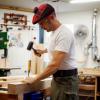Hi,
Potentially dumb question:
Can you just screw into plywood endgrain? No pocket screws. Just literally pilot hole perpendicular into the 'end grain' and then screw into it?
My friend is making drawers for his pickup truck and long story short, he has a metal frame and wants to put plywood into the metal frame. So he was thinking of building a metal frame like a picture frame and then putting the plywood in the middle. He wants to screw the plywood into place from the outside of the metal box inward. The screws would go straight into the frame.
Attached picture because I'm terrible with words
0201181124a.jpg





 Reply With Quote
Reply With Quote






